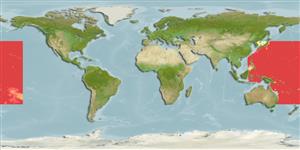Preferred temperature (Ref.
115969): 4.4 - 6.7, mean 5.5 (based on 30 cells).
Índice de diversidade filogenética (Ref.
82804): PD
50 = 0.5001 [Uniqueness, from 0.5 = low to 2.0 = high].
Bayesian length-weight: a=0.00372 (0.00152 - 0.00908), b=3.19 (2.97 - 3.41), in cm Total Length, based on LWR estimates for this (Sub)family-body shape (Ref.
93245).
Nível Trófico (Ref.
69278): 3.1 ±0.24 se; based on food items.
Fishing Vulnerability (Ref.
59153): Low vulnerability (10 of 100).
